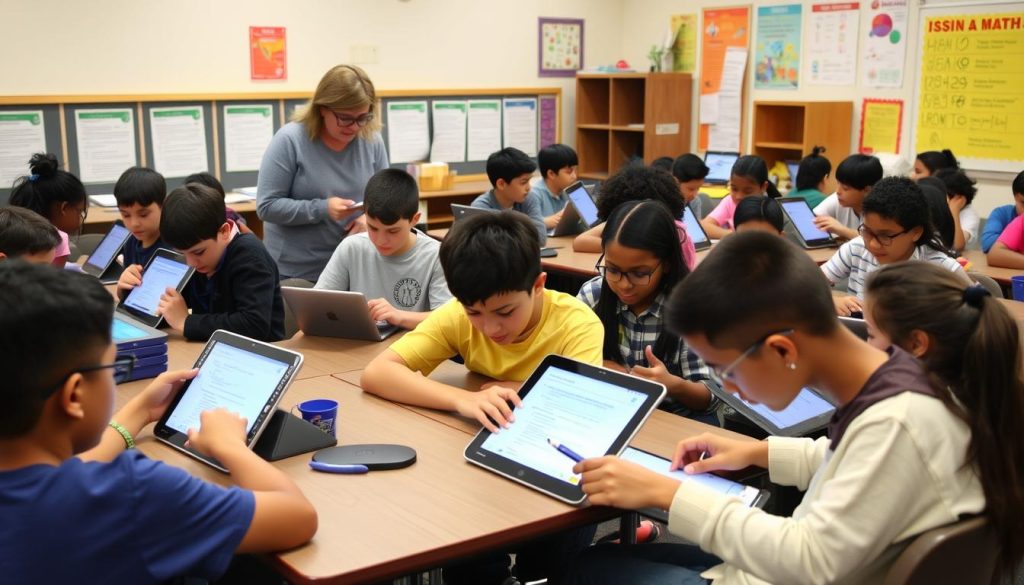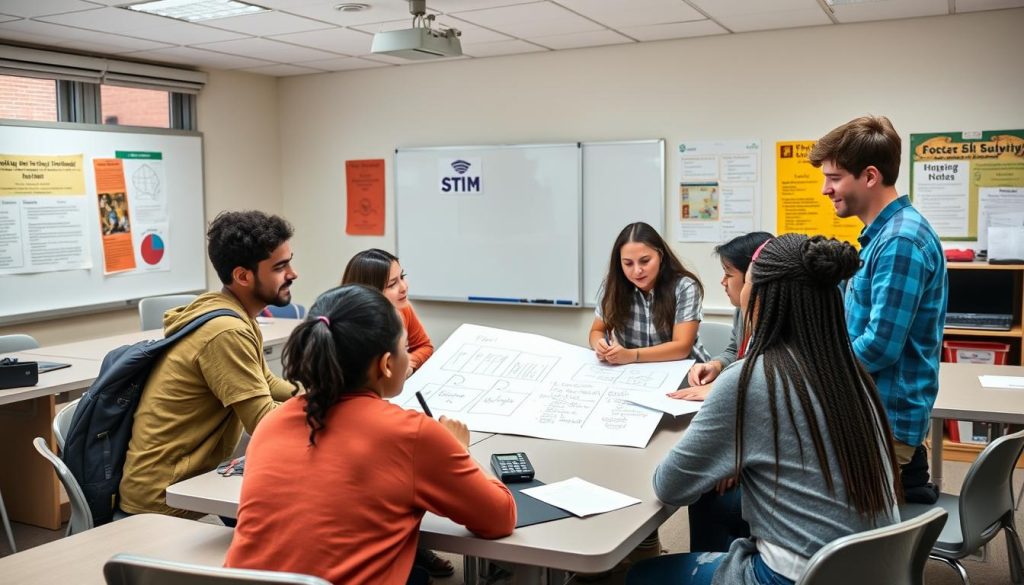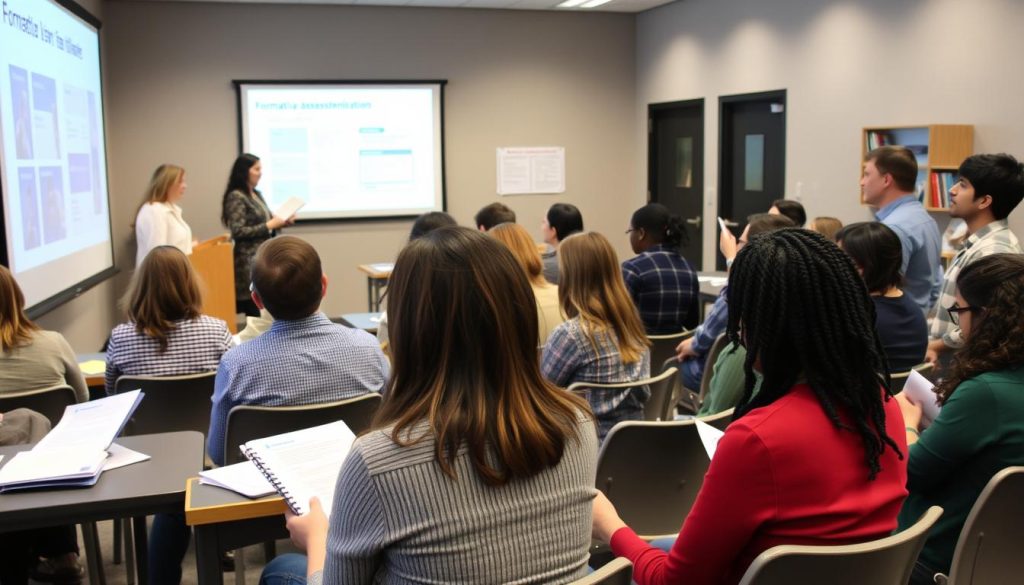25 Formative Assessment Examples for Elementary Classrooms
Quick Checks for Understanding
- Thumbs Up/Down/Sideways – Ask students to show thumbs up if they understand, thumbs down if they’re confused, or thumbs sideways if they’re not quite sure. This simple technique helps develop teacher skills in quickly gauging class comprehension.
- Traffic Light Cards – Students hold up green, yellow, or red cards to indicate their level of understanding. Green means “I understand,” yellow means “I’m a little confused,” and red means “I need help.”
- Emoji Response – Students draw or select emojis that represent their feelings about the lesson content. This helps develop teacher skills in emotional intelligence and student engagement.
- Fist to Five – Students hold up 0-5 fingers to show their confidence level with the material (fist meaning no understanding, five fingers meaning complete mastery).
- Whiteboards – Students write answers on individual whiteboards and hold them up for quick assessment. This develops teacher skills in rapid response analysis.
Creative Expression Assessments
- Draw It – Students draw a picture that represents their understanding of a concept. This helps develop teacher skills in visual learning assessment.
- Sing It – Create simple songs about key concepts and have students fill in missing words or phrases.
- Act It Out – Students use physical movements to demonstrate understanding of concepts like states of matter or the water cycle.
- Story Retelling – Students retell a story in their own words, demonstrating comprehension.
- Puppet Shows – Students use puppets to explain concepts or retell stories, revealing their level of understanding.
Written Formative Assessments
- Exit Tickets – Students complete a brief written response before leaving class. This develops teacher skills in targeted question design.
- Entrance Slips – Similar to exit tickets but used at the beginning of class to activate prior knowledge.
- 3-2-1 Strategy – Students write 3 things they learned, 2 questions they have, and 1 connection they made.
- Sentence Stems – Provide sentence starters like “I learned that…” or “I’m still confused about…” for students to complete.
- Picture Notes – Students create visual notes combining words and pictures to show understanding.
Game-Based Assessments
- Four Corners – Label classroom corners with different answers or opinions and have students move to the corner that matches their thinking.
- Bingo Review – Create bingo cards with key concepts or vocabulary for a fun review activity.
- Concept Charades – Students act out vocabulary words or concepts while others guess.
- Hopscotch Quiz – Create a hopscotch grid with questions in each square. Students answer as they hop.
- Beach Ball Questions – Write questions on a beach ball. Students answer the question under their right thumb when they catch the ball.
Collaborative Assessments
- Think-Pair-Share – Students think individually, pair with a partner to discuss, then share with the class. This develops teacher skills in facilitating productive discussions.
- Gallery Walk – Students create work and post it around the room, then walk around to view and comment on others’ work.
- Jigsaw – Students become “experts” on a topic and teach it to their peers.
- Snowball Fight – Students write a question or answer on paper, crumple it, and toss it. They then pick up a “snowball” and respond.
- Partner Quiz – Students quiz each other using teacher-provided questions, developing peer teaching skills.
“Formative assessment isn’t just about checking understanding—it’s about creating opportunities for students to demonstrate their thinking in different ways. The best elementary teachers develop their teacher skills by collecting this information and using it to shape instruction in real-time.”
Enhance Your Elementary Assessment Skills
Looking to master these formative assessment techniques? Our “Formative Assessment in Elementary Classrooms” course offers practical implementation strategies and earns you professional development credits.
25 Formative Assessment Examples for Middle School Classrooms

Middle school students require formative assessment examples that acknowledge their growing independence while providing the structure they need. These techniques will help you develop teacher skills specific to adolescent learners.
Digital Formative Assessments
- Digital Polls – Use online polling tools to gather quick feedback from students. This develops teacher skills in technology integration.
- Online Exit Tickets – Create digital forms for students to complete before leaving class.
- Video Responses – Students record short video explanations of concepts.
- Digital Concept Maps – Students create online mind maps showing relationships between ideas.
- Social Media Templates – Students summarize learning using mock social media posts or profiles for historical figures or scientific concepts.
Written Reflection Assessments
- One-Minute Papers – Students write for one minute answering a specific question about the day’s learning.
- Learning Logs – Students maintain ongoing journals documenting their learning process.
- Muddiest Point – Students identify the concept they find most confusing from the lesson.
- 3-2-1 Bridge – Students note 3 thoughts, 2 questions, and 1 analogy before a lesson, then revisit after instruction.
- Summary Tweets – Students summarize learning in 280 characters or less.
Visual Formative Assessments
- Sketch Notes – Students create visual notes combining text, images, and organization.
- Concept Cartoons – Students create or complete comics that demonstrate scientific or mathematical concepts.
- Infographics – Students create simple infographics to explain processes or concepts.
- Color Coding – Students use different colors to categorize information or show relationships.
- Visual Metaphors – Students create visual comparisons to explain abstract concepts.
Interactive Assessments
- Four Corners Debate – Students move to corners representing strongly agree, agree, disagree, or strongly disagree, then justify their position.
- Quiz-Quiz-Trade – Students create question cards, quiz a partner, trade cards, and find a new partner.
- Hot Seat – One student sits in the “hot seat” and answers questions from peers about a topic.
- Socratic Seminar – Students engage in structured discussion about a text or topic.
- Carousel Brainstorming – Small groups rotate through stations, adding ideas to chart paper at each stop.
Self-Assessment Strategies
- Confidence Ratings – Students rate their confidence in specific skills or concepts on a scale.
- Self-Scoring Rubrics – Students evaluate their own work using teacher-provided rubrics.
- Progress Tracking – Students maintain charts of their progress toward learning goals.
- Error Analysis – Students analyze their own mistakes and explain correct approaches.
- Goal Setting – Students set specific learning goals and reflect on their progress.
Pro Tip for Teacher Skills: When implementing these middle school formative assessment examples, provide clear success criteria so students know what mastery looks like. This transparency develops metacognitive skills and helps students take ownership of their learning journey.
25 Formative Assessment Examples for High School Classrooms

High school students benefit from formative assessment examples that prepare them for college and careers while developing critical thinking skills. These techniques will strengthen your teacher skills in supporting advanced learners.
Critical Thinking Assessments
- Socratic Questioning – Use targeted questions to probe student understanding and reveal misconceptions.
- Case Studies – Students analyze real-world scenarios and apply course concepts.
- Debate Preparation – Students outline arguments for different perspectives on controversial topics.
- Claim-Evidence-Reasoning – Students make a claim, provide evidence, and explain their reasoning.
- Philosophical Chairs – Students physically position themselves along a continuum based on their stance on an issue, then justify their position.
Peer Assessment Strategies
- Peer Review Workshops – Students provide structured feedback on each other’s work.
- Critical Friends Protocol – Students follow a structured protocol to give constructive feedback.
- Gallery Critique – Students post work and receive written feedback from peers using specific criteria.
- Blind Peer Review – Students anonymously review each other’s work using a rubric.
- Fishbowl Discussions – Inner circle of students discusses while outer circle observes and provides feedback.
Technology-Enhanced Assessments
- Digital Portfolios – Students curate evidence of their learning in online portfolios.
- Screencast Explanations – Students record their screen while explaining a process or solving a problem.
- Collaborative Documents – Students work together on shared documents with teacher monitoring.
- Podcast Creation – Students create short podcasts explaining concepts or discussing issues.
- Interactive Simulations – Students manipulate variables in online simulations and explain outcomes.
Writing-Based Assessments
- Dialectical Journals – Students record quotes or ideas and their personal responses.
- Synthesis Matrix – Students organize information from multiple sources in a grid format.
- Précis Writing – Students write concise summaries of complex texts.
- Annotated Bibliographies – Students summarize and evaluate sources on a research topic.
- Position Papers – Students write brief arguments supporting a position on a controversial issue.
Real-World Application Assessments
- Problem-Based Scenarios – Students apply learning to solve authentic problems.
- Project Checkpoints – Regular check-ins during extended projects to assess progress.
- Elevator Pitches – Students create concise explanations of complex concepts.
- Mock Interviews – Students demonstrate knowledge through interview-style questioning.
- Teaching Demonstrations – Students teach a concept to the class, revealing their understanding.
“The most effective high school formative assessments don’t just measure what students know—they challenge students to apply knowledge in new contexts. This is where teacher skills in designing authentic assessments become crucial for preparing students for future success.”
According to research from the Brookings Institution, formative assessment is most effective when feedback is specific, timely, and actionable. These high school formative assessment examples are designed with these principles in mind, helping you develop teacher skills in providing meaningful feedback.
How These Formative Assessment Examples Strengthen Teacher Skills

Implementing these formative assessment examples doesn’t just benefit your students—it significantly enhances your teacher skills in several key areas. Let’s explore how these practices contribute to your professional growth:
Responsive Teaching
Formative assessment examples provide immediate feedback that allows you to adjust your instruction in real-time. This develops your teacher skills in responsive teaching—the ability to pivot based on student needs rather than rigidly following a lesson plan. Research shows that this adaptive approach has one of the highest impacts on student achievement.
Differentiation Expertise
As you implement various formative assessment examples, you’ll become more skilled at identifying specific learning needs and tailoring instruction accordingly. This strengthens your teacher skills in differentiation—providing multiple pathways to learning based on readiness, interest, and learning profile.
Data Literacy
Regular use of formative assessment examples generates valuable data about student learning. Analyzing this information develops your teacher skills in data literacy—the ability to interpret assessment results and translate them into actionable teaching strategies.
Questioning Techniques
Many formative assessment examples rely on effective questioning. As you practice these techniques, you’ll refine your teacher skills in asking questions that promote deeper thinking and reveal true understanding rather than surface knowledge.
Feedback Delivery
Providing timely, specific feedback is central to formative assessment. These examples help you develop teacher skills in delivering feedback that is constructive, growth-oriented, and actionable for students.
Benefits for New Teachers
- Builds confidence in instructional decision-making
- Provides structure for checking understanding
- Helps establish effective classroom routines
- Creates opportunities for meaningful student interactions
- Develops diagnostic skills for identifying learning gaps
Benefits for Experienced Teachers
- Refreshes instructional approaches
- Deepens understanding of student thinking processes
- Provides new tools for challenging advanced students
- Offers alternatives to traditional assessment methods
- Strengthens teacher-student relationships through feedback loops
Take Your Teacher Skills to the Next Level
Ready to master formative assessment? Our comprehensive course “Advanced Formative Assessment Strategies” provides in-depth training on implementing these techniques while earning valuable professional development credits.
Using Formative Assessment Examples to Earn Professional Development Credits

Implementing formative assessment examples in your classroom doesn’t just improve student outcomes—it can also advance your career through professional development credits. Here’s how you can leverage your formative assessment practice for professional growth:
Document Your Implementation
Create a portfolio documenting how you’ve implemented various formative assessment examples in your classroom. Include sample assessments, student work samples (with identifying information removed), and your reflections on the process. This documentation can serve as evidence for professional development credit in many districts.
Action Research Projects
Design an action research project focused on implementing specific formative assessment examples and measuring their impact on student learning. Many districts and universities offer professional development credits for completed action research projects that enhance teacher skills.
Professional Learning Communities
Form or join a Professional Learning Community (PLC) focused on formative assessment. Regular participation in PLCs often qualifies for professional development credit while providing valuable collaboration opportunities to enhance your teacher skills.
Formal Coursework
Enroll in structured courses specifically designed to develop your teacher skills in formative assessment. Credits for Teachers offers accredited courses that translate directly to salary advancement credits in many districts.
Did You Know? Many school districts offer salary advancement for teachers who demonstrate improved student outcomes through effective assessment practices. Documenting your use of these formative assessment examples can provide evidence for performance-based compensation systems.
Sharing Your Expertise
Once you’ve mastered various formative assessment examples, consider presenting at conferences or leading professional development sessions for colleagues. Many districts award professional development credits for teachers who share their expertise, further enhancing your teacher skills and professional reputation.
Online PD Options
- Self-paced assessment courses
- Virtual coaching on feedback techniques
- Webinars on data-driven instruction
- Digital badges for assessment competencies
- Online learning communities
In-Person PD Options
- Summer institutes on assessment
- District-sponsored workshops
- University partnerships
- Instructional rounds focused on assessment
- Demonstration classrooms
Transform Your Assessment Practice
Our “Formative Assessment Certification” program provides comprehensive training on all 75 formative assessment examples covered in this article, plus implementation strategies and ready-to-use templates.
Conclusion: Making Formative Assessment Work for You
The 75 formative assessment examples we’ve explored represent powerful tools for enhancing both student learning and your teacher skills. Remember that effective implementation isn’t about using all of these techniques—it’s about selecting the right tools for your specific classroom context, content area, and student needs.
Start by choosing 2-3 new formative assessment examples to implement in your classroom next week. As you become comfortable with these techniques, gradually expand your repertoire. Pay attention to which methods provide the most valuable insights for your particular students and subject area.
Most importantly, use the information you gather through these formative assessment examples to make meaningful adjustments to your instruction. The true power of formative assessment lies not in the collection of data, but in how that data transforms your teaching practice and ultimately improves student outcomes.
By continuously refining your teacher skills through formative assessment, you’ll create a more responsive, engaging, and effective learning environment for all students. And by documenting this journey, you can earn valuable professional development credits that advance your career while enhancing your classroom practice.
Ready to Transform Your Assessment Practice?
Visit Credits for Teachers to explore our complete catalog of professional development courses designed to enhance your teacher skills and advance your career.




